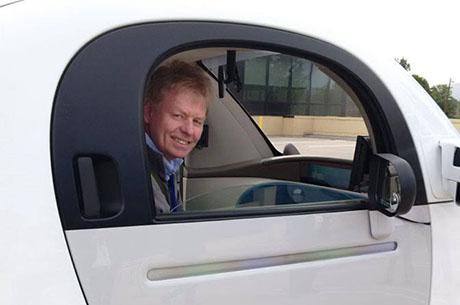3 Questions: John Leonard on the future of autonomous vehicles
As part of the MIT Task Force on the Work of the Future’s new series of research briefs, Professor John Leonard teamed with professor of aeronautics and astronautics and of history David Mindell and with doctoral candidate Erik Stayton to explore the future of autonomous vehicles (AV) — an area that could arguably be called the touchstone for the discussion of jobs of the future in recent years. Leonard is the Samuel C. Collins Professor of Mechanical and Ocean Engineering in the Department of Mechanical Engineering, a member of the Computer Science and Artificial Intelligence Laboratory (CSAIL), and member of the MIT Task Force on the Work of the Future. His research addresses navigation and mapping for autonomous mobile robots operating in challenging environments.
Their research brief, “Autonomous Vehicles, Mobility, and Employment Policy: The Roads Ahead,” looks at how the AV transition will affect jobs and explores how sustained investments in workforce training for advanced mobility can help drivers and other mobility workers transition into new careers that support mobility systems and technologies. It also highlights the policies that will greatly ease the integration of automated systems into urban mobility systems, including investing in local and national infrastructure, and forming public-private partnerships. Leonard spoke recently on some of the findings in the brief.
Q: When would you say Level 4 autonomous vehicle systems — those that can operate without active supervision by a human driver — increase their area of operation beyond today’s limited local deployments?
A: The widespread deployment of Level 4 automated vehicles will take much longer than many have predicted — at least a decade for favorable environments, and possibly much longer. Despite substantial recent progress by the community, major challenges remain before we will see the disruptive rollout of fully automated driving systems that have no safety driver onboard over large areas. Expansion will likely be gradual, and will happen region-by-region in specific categories of transportation, resulting in wide variations in availability across the country. The key question is not just “when,” but “where” will the technology be available and profitable?
Driver assistance and active safety systems (known as Level 2 automation) will continue to become more widespread on personal vehicles. These systems, however, will have limited impacts on jobs, since a human driver must be on board and ready to intervene at any moment. Level 3 systems can operate without active engagement by the driver for certain geographic settings, so long as the driver is ready to intervene when requested; however, these systems will likely be restricted to low-speed traffic.
Impacts on trucking are also expected to be less than many have predicted, due to technological challenges and risks that remain, even for more structured highway environments.
Q: In the brief, you make the argument that AV transition, while threatening numerous jobs, will not be “jobless.” Can you explain? What are the likely impacts to mobility jobs — including transit, vehicle sales, vehicle maintenance, delivery, and other related industries?
A: The longer rollout time for Level 4 autonomy provides time for sustained investments in workforce training that can help drivers and other mobility workers transition into new careers that support mobility systems and technologies. Transitioning from current-day driving jobs to these jobs represents potential pathways for employment, so long as job-training resources are available. Because the geographical rollout of Level 4 automated driving is expected to be slow, human workers will remain essential to the operation of these systems for the foreseeable future, in roles that are both old and new.
In some cases, Level 4 remote driving systems could move driving jobs from vehicles to fixed-location centers, but these might represent a step down in job quality for many professional drivers. The skills required for these jobs is largely unknown, but they are likely to be a combination of call-center, dispatcher, technician, and maintenance roles with strong language skills. More advanced engineering roles could also be sources of good jobs if automated taxi fleets are deployed at scale, but will require strong technical training that may be out of reach for many.
Increasing availability of Level 2 and Level 3 systems will result in changes in the nature of work for professional drivers, but do not necessarily impact job numbers to the extent that other systems might, because these systems do not remove drivers from vehicles.
While the employment implications of widespread Level 4 automation in trucking could eventually be considerable, as with other domains, the rollout is expected to be gradual. Truck drivers do more than just drive, and so human presence within even highly automated trucks would remain valuable for other reasons such as loading, unloading, and maintenance. Human-autonomous truck platooning, in which multiple Level 4 trucks follow a human-driven lead truck, may be more viable than completely operator-free Level 4 operations in the near term.
Q: How should we prepare policy in the three key areas of infrastructure, jobs, and innovation?
A: Policymakers can act now to prepare for and minimize disruptions to the millions of jobs in ground transportation and related industries that may come in the future, while also fostering greater economic opportunity and mitigating environmental impacts by building safe and accessible mobility systems. Investing in local and national infrastructure, and forming public-private partnerships, will greatly ease integration of automated systems into urban mobility systems.
Automated vehicles should be thought of as one element in a mobility mix, and as a potential feeder for public transit rather than a replacement for it, but unintended consequences such as increased congestion remain risks. The crucial role of public transit for connecting workers to workplaces will endure: the future of work depends in large part on how people get to work.
Policy recommendations in the trucking sector include strengthening career pathways for drivers, increasing labor standards and worker protections, advancing public safety, creating good jobs via human-led truck platooning, and promoting safe and electric trucks.

